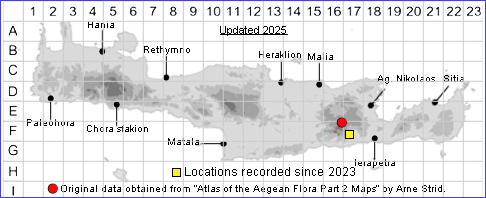ASTRAGALUS IDEAUS
Family and Genus:- See- LEGUMINOSAE/Subgen. CERCIDOTHRIX
Common Names:- None
Homotypic Synonyms:- None
Meaning:- Astragalus (Gr) Ankle-bone,(a plant with knotted roots).
Idaeus (L) From Mount Ida in Crete, or Mount Ida in NW. Turkey.
General description:- Woody-based perennial forming small, flat clumps.
Leaves:-
1) Imparipinnate, up to 3 cm.
a) leaflets, (5-)6-10 pairs, 3-6 x 1-2 mm, oblong-elliptical, densely silky, clothed
with closely appressed, soft, straight pubescence hairs on both surfaces.
Flowers:-
1) Peduncles, shorter than or equalling leaves.
2) Raceme, globose, 25-40 mm across, 12-20-flowered.
3) Calyx, c. 7 mm, with unequally bifurcate, black and white hairs.
a) teeth, c. half as long as the tube.
4) Corolla, bright lemon yellow.
a) standard, 15-20 mm, obovate.
5) Infructescence, erect.
Fruit:-
1) Legume, 8-10 mm, narrowly ovoid, witha curved beak 3-4 mm, with long simple
white hairs and occasional black hairs underneath.
2) Seeds, 2-5
Habitat:- Dry, rocky and stony limestone slopes and plateaus. 1800-2000 m.
Distribution:- Cretan Endemic. Extremely rare. Known only from the Dikti massif.
Flowering time:- Mid-May to mid-June.
Photos by:- Yannis Zacharakis & Christopher Cheiladakis
Status:-
Conservation status (for threatened species): Probably extinct according to the
Red Data Book of Rare and Threatened Plants of Greece
(1995) Extinct or endangered according to IUCN 1997
Protection status (for threatened species): Greek Presidential Decree 67/1981.
SPECIES DESCRIPTION

